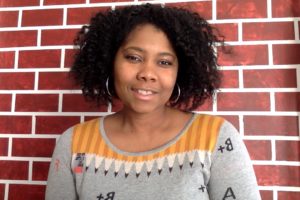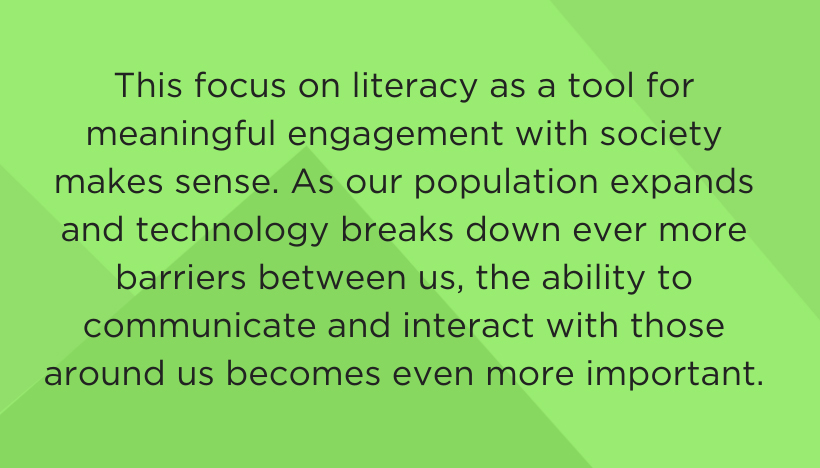From the NCTE Standing Committee on Global Citizenship
This post was written by NCTE member Amber Peterson, a member of the NCTE Standing Committee on Global Citizenship.
“History is written by the victors.” —Unknown
As committee members, we regularly wrestle with pinning down a comprehensive definition of literacy. The common definition, “the ability to read and write,” gets increasingly complex upon closer examination. What does mastery of reading and writing look like? How do we measure it? How do we weigh digital and technological proficiency? Where does numeracy come in? How do the values of our communities and cultural practices come into play? sWhen measuring literacy, which languages and dialects count and which do not?
Despite the complexity, literacy is the global metric we use to assess the health and competence of communities. High literacy rates have been found to correlate to everything from better access to economic opportunity, to better nutrition, to environmental sustainability.
In fact, bolstering global literacy underpins all of UNESCO’s 2030 Sustainability Goals, acknowledging the fact that ideals like gender equality, sustainable infrastructure, and eradicating poverty and hunger are not possible without literate populations. Correspondingly, UNESCO’s hefty definition of literacy is “a means of identification, understanding, interpretation, creation, and communication in an increasingly digital, text-mediated, information-rich and fast-changing world.” (UNESCO)
This focus on literacy as a tool for meaningful engagement with society makes sense. As our population expands and technology breaks down ever more barriers between us, the ability to communicate and interact with those around us becomes even more important. In our consideration of literacy, however, it is impossible to ignore the myriad ways that imperialist and colonialist systems shape gender and regional disparities in access.
Many historians propose that written language emerged at least in part as a tool for maintaining power. One’s class status dictated one’s access to literacy education, and often those without power were prohibited from learning to read and write at all. Colonialism, imperialism, and the sprawl of anglo-european, male-centered ideology from the 15th Century onward have created global power structures that still dominate today.
When considered from that perspective, it is no surprise that women make up two thirds of the world’s illiterate population, and that sub-Saharan Africa, the region arguably hit hardest by many of those inequitable power structures, has some of the lowest literacy levels in the world.
While our focus must and should be on providing everyone everywhere with the tools to “identify, understand, interpret, create, and communicate in an increasingly digital, text-mediated, information-rich, and fast changing world,” those persistent inequitable power structures dictate that progress will always be lopsided and slow.
As we slog onward, perhaps we also need to examine and consider more closely the world and experience of the “illiterate” as well. Only relatively recently has literacy been expected or even possible for the vast majority of society. For centuries, people have lived, laughed, traded, communicated, and survived without being able to read and write. Even today, though illiteracy can be a literal death sentence (studies have shown that female literacy rates can actually be a predictor of child mortality rates (Saurabh et al)), it is most certainly a metaphorical one wherein the experiences had and contributions made by those so afflicted are devalued both by design and by conceit.
We doom entire cultures and erase the experiences of entire populations by embracing the superiority of those who are literate, but illiteracy doesn’t mean ignorance. We can and should learn from everyone and we must provide other avenues to global citizenship for those who can’t read and write.
So what does this mean for our definition of literacy? At its simplest, literacy is the way that we interact with the world around us, how we shape it and are shaped by it. It is how we communicate with others via reading and writing, but also by speaking, listening, and creating. It is how we articulate our experience in the world and declare, “We Are Here!”
In my work as the director of program innovation for LitWorld, I get to interact with young people all over the world and examine the idea of literacy from many different angles. Resources for literacy education differ dramatically from one place to another, as do metric taking procedures and general best practices.
What does not change is the inherent drive for people to express themselves, to learn, and to grow. I see the enthusiasm with which young people jump at the chance to share stories of themselves and of the world, to be listened to and to absorb. I also see firsthand the devastating effect of being told that your story, your community, and your culture do not matter. I have witnessed the loss of confidence, the dwindling self-esteem, and the cycle of hopelessness that comes with the silencing of voices.
It is our charge as educators and as global citizens to embrace literacy in ALL of its forms.
5 Suggestions for Embracing Literacy for Global Citizenship in the Classroom
- Focus on students’ own stories. Find ways to center their experiences and lean in to opportunities to share them both informally and formally.
- Embrace ALL of the languages your students speak. Being multilingual is an asset, not a deficit! Many of our students are multilingual in ways we never acknowledge. Mastery of formal and standardized language structures is an important tool that every student deserves access to, but life often happens outside of and around those structures. Those everyday interactions are important, valuable, and valid as well.
- Provide regular access to diverse stories, images, experiences, and perspectives. The world is enormous and that diversity is beautiful. Help your students to see it as such. Providing access to underrepresented narratives and accounts helps to decolonize your classroom and normalize embracing the unfamiliar.
- Place value on reading, writing, speaking, listening, and creating in your students’ work. Ensure that reading and writing are not the only ways in which students are acknowledged and celebrated for taking in ideas, expressing their thoughts, or demonstrating understanding. Encouraging multiple modes of expression not only provides more opportunities for students to explore and display their own intelligence, it also primes them to seek information, inspiration, and knowledge from diverse sources.
- Read aloud together, and often. Reading aloud is effective across grade levels, despite the fact that this critical practice usually stops in elementary school. Reading aloud can provide access to content that students might not be able to access on their own. It is also a way of creating community and building a shared experience as a whole class.
The Standing Committee on Global Citizenship works to identify and address issues of broad concern to NCTE members interested in promoting global citizenship and connections across global contexts within the Council and within members’ teaching contexts.
Sources
Literacy. (2018, March 19). Retrieved March 2, 2020, from https://en.unesco.org/themes/literacy
Saurabh, S., Sarkar, S., & Pandey, D. K. (2013). Female Literacy Rate is a Better Predictor of Birth Rate and Infant Mortality Rate in India. Retrieved March 2, 2020, from https://www.ncbi.nlm.nih.gov/pmc/articles/PMC4649870/
The Sustainable Development Agenda—United Nations Sustainable Development. (n.d.). Retrieved March 2, 2020, from https://www.un.org/sustainabledevelopment/development-agenda/
 Amber Peterson is the director of program innovation at LitWorld, a nonprofit that promotes literacy and social emotional development through storytelling. She holds a bachelor’s degree in English literature, theater, and geology from Oberlin College, and a masters in education from St. John’s University, and has worked as a public school teacher, educational consultant, and educational coach in the United States and abroad.
Amber Peterson is the director of program innovation at LitWorld, a nonprofit that promotes literacy and social emotional development through storytelling. She holds a bachelor’s degree in English literature, theater, and geology from Oberlin College, and a masters in education from St. John’s University, and has worked as a public school teacher, educational consultant, and educational coach in the United States and abroad.

